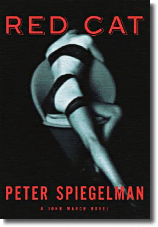 Peter Spiegelman is the author of three John March novels. His debut novel, Black Maps, was published by Knopf in August, 2003 and won the 2004 Shamus Award for Best First Novel. It was followed in 2005 by Death's Little Helpers, which Ken Bruen called "...a multi-layered novel of compassion and power."
Peter Spiegelman is the author of three John March novels. His debut novel, Black Maps, was published by Knopf in August, 2003 and won the 2004 Shamus Award for Best First Novel. It was followed in 2005 by Death's Little Helpers, which Ken Bruen called "...a multi-layered novel of compassion and power."And last month Knopf brought out the third terrific John March novel, Red Cat.
Spiegelman put Red Cat to the "Page 99 Test" and reported the following:
At first it struck me as a little like phrenology, or reading tea leaves — the notion that one page of a novel could reveal “the quality of the whole.” Then I gave it a try with Red Cat. While I won’t say I’m completely sold on the idea, it turns out that page 99 provides some nice examples of certain things I try to do in my writing.Visit Peter Spiegelman's official website, and read my rave Spot-on review of Red Cat.
On this page, private investigator John March, the protagonist of Red Cat and of my two previous books, is calling on Jorge Arrua, the neighbor of a woman March has been searching for. Arrua is reluctant to provide March with any information, and March has had to pay for Arrua’s cooperation, not in cash but by making a trip to the market for the elderly gent (it’s an icy winter day). The page begins with March delivering the groceries, and seeing Arrua for the first time.
He was a small man, worn but well-kempt in khakis, a gray cardigan, and a white shirt. His apartment was much the same. The living room was a narrow rectangle with white walls, beige trim, and a hardwood floor that had seen rough use, but also recent waxing. There were two windows that looked onto a fire escape, and that were fortified by metal accordion gates. In front of them was a sofa covered in gray fabric, with arms that had frayed and been carefully mended. There was a bookshelf in the corner, stocked with Spanish titles, and some pictures hanging above it. A photo clipped from a newspaper and yellowing under glass: Argentine soccer players in white and sky blue, and Maradona’s infamous “hand of God” goal against England. Next to it, a plaque commemorating twenty-five years of service to the Metropolitan Transit Authority — hail and farewell, Car Maintenance Engineer Jorge Arrua. Next to that, another photo, black and white, of a pale, pretty, sick-looking woman in a high-necked dress. Wife, mother, sister, daughter — whoever she was, I got the impression that she hadn’t survived her illness, and that it had all happened long ago.
[Excerpted from Red Cat by Peter Spiegelman Copyright © 2007 by Peter Spiegelman. Excerpted by permission of Knopf, a division of Random House, Inc. All rights reserved. No part of this excerpt may be reproduced or reprinted without permission in writing from the publisher.]
One of the things I try to do in my books is to give even minor characters as much life as I can, and one way I do that is through setting. This passage provides a good example. The apartment is worn but well-tended, and in this way is like Arrua himself — a bit battered, but with dignity intact. It’s also somewhat lonely — clearly the home of one person, not of a couple or of a family. There’s a forlorn quality to the place (the yellowed newspaper clipping, the retirement plaque, the woman’s photo), just as there is to Arrua himself.
There’s something else going on too, less obvious but perhaps more to Ford’s point. Red Cat is told in first person, and everything the reader knows is mediated through the character of March. So, besides telling us a story, March’s narration tells us a lot about March himself. Everything he reveals about Arrua — the dignity, the loneliness, the hint of sadness—also reveals something about March: his powers of observation, his emotional sensitivity, and the sorts of things he’s attuned to. That kind of access to a character is one of the great strengths and pleasures of first person narration, and something I try to take advantage of.
--Marshal Zeringue



